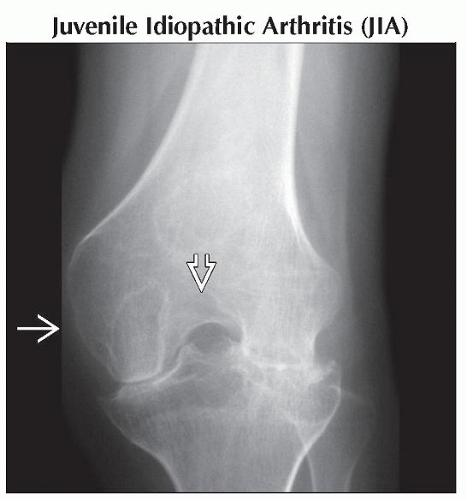Long Bone, Epiphyseal, Overgrowth/Ballooning
B. J. Manaster, MD, PhD, FACR
DIFFERENTIAL DIAGNOSIS
Common
Juvenile Idiopathic Arthritis (JIA)
Hemophilia: MSK Complications
Less Common
Septic Joint
Epiphyseal Fracture, Pediatric
Epiphyseal Dysplasia
Hyperemia, Other Causes
Turner Syndrome (Mimic)
Blount Disease (Mimic)
Rare but Important
Meningococcemia (Mimic)
ESSENTIAL INFORMATION
Key Differential Diagnosis Issues
Hyperemia is fundamental cause of overgrowth in several cases
In skeletally immature patient
Prolonged hyperemia adjacent to joint → overgrowth (ballooning) of epiphysis
In addition to enlarged epiphysis, hyperemia → early physeal fusion → short limb
Etiologies of overgrowth secondary to hyperemia include
Hemophilia
Juvenile idiopathic arthritis
Septic joint, particularly tuberculosis or fungal etiology
Epiphyseal or metaphyseal fracture
Helpful Clues for Common Diagnoses
Juvenile Idiopathic Arthritis (JIA)
Hemophilia: Similar to JIA
Chronic hyperemia from synovitis (JIA) or recurrent intraarticular bleed (hemophilia)
Knee > elbow > ankle
Erosion of intercondylar or trochlear notch
Erosions, cartilage loss in both
JIA may be distinguished by carpal fusion
Hemophilia may be distinguished by dense effusion (hemosiderin deposition)
Helpful Clues for Less Common Diagnoses
Septic Joint
Effusion, cartilage loss, erosions
Tuberculosis or fungal etiologies more likely to result in overgrowth than bacterial
Slower joint destruction, so occurs over longer period of time, allowing chronic hyperemia
Less likely to have reactive osseous change than bacterial etiology
Epiphyseal Fracture, Pediatric
Hyperemia with fracture healing results in overgrowth
Watch for malunion
Epiphyseal Dysplasia
May be fragmented in severe cases or overgrown if less severe
Turner and Blount Disease (Mimics)
Underdevelopment or collapse of medial tibial condyle results in relative overgrowth of medial femoral condyle
Image Gallery
 AP radiograph shows significant enlargement (overgrowth) of the femoral epiphyses
 relative to the diaphyses. There are severe erosions and widening of the intercondylar notch relative to the diaphyses. There are severe erosions and widening of the intercondylar notch  in this patient with JIA. in this patient with JIA.Stay updated, free articles. Join our Telegram channel
Full access? Get Clinical Tree
 Get Clinical Tree app for offline access
Get Clinical Tree app for offline access

|